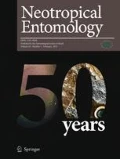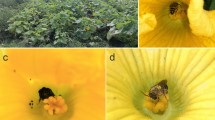Abstract
Studies in crop plants analyzing floral biology in conjunction with effectiveness and efficiency of pollinators on pollen transfer and fruit formation are not common, although they are essential to provide better management actions. On this base, we selected a farm in Bahia, Brazil, to study pollination on coffee plants (Coffea arabica L.). Specifically, we want to analyze if nectar traits influence visitor’s performance throughout flower lifetime and if honeybees (Apis mellifera scutellata Lepeletier, 1836) are effective and efficient for coffee pollination comparing fertilization and fructification among four experimental treatments: open (OP), wind (WP), cross (HCP), and single-visit bee pollination (SVBP). We found that honeybees collect both nectar and pollen from coffee flowers and transfer pollen on stigmas even after one visit. No differences were found among treatments regarding the number of pollen grains transferred on the stigmas (effectiveness). OP flowers showed a comparative lower efficiency (pollen tubes and fruit set) probably due to pollination failure as those flowers have a higher variability on the number of deposited pollen grains. Two of the treatments (HCP and SVBP) showed higher fertilization (measuring tubes until the end of the style). Pollen loads seem to be limited by a peak of pollen transference by pollinators, followed by the stabilization in the number of pollen grains deposited per stigma. Thus, reproduction of the coffee can be limited by the quality of pollen grains moved by pollinators instead of quantity. Management strategies should focus on monitoring bee density on plants for increasing pollen quality transfer on flowers trough maintaining the adequate proportions of seminatural habitats and/or the number of hives on agricultural fields according to the flowering of the crop.




Similar content being viewed by others
References
Abou-Shaara H (2014) The foraging behaviour of honey bees, Apis mellifera: a review. Veterinarni Medicina 59:1–10. https://doi.org/10.17221/7240-VETMED
Aizen M, Harder LD (2007) Concepts & synthesis emphasizing new ideas to stimulate research in ecology expanding the limits of the pollen-limitation concept: effects of pollen quantity and quality. Ecology 88:271–281
Altieri MA, Nichols CI, Gillespie M, Waterhouse B, Wratten S, Gbèhounu G, Gemmill-Herren B. Crops, weed and pollinators:understanding ecological interaction for better management. Rome, FAO 95 p.
Amaral E (1952) Essay on the influence of Apis mellifera L. on the pollination of the coffee plant. Preliminary note. Escola Superior de Agricultura “Luiz de Queiroz” Boletim 9, Escola Superior de Agricultura “Luiz de Queiroz”, So Paulo, Brazil
Badilla F, Ramirez B (1991) Polinizacion de cafe por Apis mellifera L. y otros insectos en Costa Rica. Turrialba 41:285–288
Bergmeyer HV, Bernt E (1974) Methods of enzymatic analysis. In: Bergmeyer HV (ed) , vol 3. Academic Press, New York, London, p 1127
Bravo-Monroy L, Tzanopoulos J, Potts SG (2015) Ecological and social drivers of coffee pollination in Santander, Colombia. Agric Ecosyst Environ 211:145–154
Burd M (2008) The Haig-Westoby model revisited. Am Nat 171:400–404. https://doi.org/10.1016/j.agee.2015.06.007
Cane J, Schiffhauer D (2003) Dose-response relationships between pollination and fruiting refine pollinator comparisons for cranberry (Vaccinium macrocarpon [ERICACEAR]). Am J Bot 90:1425–1432. https://doi.org/10.3732/ajb.90.10.1425
Classen A, Peters MK, Ferger SW et al (2014) Complementary ecosystem services provided by pest predators and pollinators increase quantity and quality of coffee yields. Proc R Soc B 281:20133148. https://doi.org/10.1098/rspb.2013.3148
Corbet S (1987) More bees make better crops. New Sci 115:40–43
De Castro RD, Marraccini P (2006) Cytology, biochemistry and molecular changes during coffee fruit development. Braz J Plant Physiol 18:175–199. https://doi.org/10.1590/S1677-04202006000100013
De Marco P, Coelho FM (2004) Services performed by the ecosystem: forest remnants influence agricultural cultures’ pollination and production. Biodivers. Conserv. 13:1245–1255. https://doi.org/10.1023/B:BIOC.0000019402.51193.e8
Galetto L, Bernadello G (2005) Nectar. In: Dafni A, Kevan PG, Husband BC (eds) Practical pollination ecology. Environquest Ltd., Ontario, pp 261–313
Garibaldi LA, Steffan-Dewenter I, Kremen C, Morales JM, Bommarco R, Cunningham SA, Carvalheiro LG, Chacoff NP, Dudenhöffer JH, Greenleaf SS, Holzschuh A, Isaacs R, Krewenka K, Mandelik Y, Mayfield MM, Morandin LA, Potts SG, Ricketts TH, Szentgyörgyi H, Viana BF, Westphal C, Winfree R, Klein AM (2011) Stability of pollination services decreases with isolation from natural areas despite honey bee visits. Ecol Lett 14:1062–1072. https://doi.org/10.1111/j.1461-0248.2011.01669.x
Hipólito J, Boscolo D, Viana B (2018) Landscape and crop management strategies to conserve pollination services and increase yields in tropical coffee farms. Agric Ecosyst Environ 256:218–225. https://doi.org/10.1016/j.agee.2017.09.038
ICO - International coffee organization (2012) ICO - International coffee organization. http://www.ico.org/
INMET. Banco de Dados Meteorológicos para Ensino e Pesquisa (2013) Database: BDMEP [Internet]. Available: http://www.inmet.gov.br/portal/index.php?r = bdmep/bdmep. Accessed November 2017
Kerr W (1967) The history of the introduction of Africanized honey bees to Brazil. S. Afr. Bee J 39: 3–5
Kho Y, Baer J (1968) Observing pollen tubes by means of fluorescence. Euphytica 17:298–302
Klein A, Steffan-Dewenter I, Tscharntke T (2003a) Fruit set of highland coffee increases with the diversity of pollinating bees. Proc Biol Sci R Soc 270:955–961. https://doi.org/10.1098/rspb.2002.2306
Klein A, Steffan-Dewenter I, Tscharntke T (2003b) Pollination of Coffea canephora in relation to local and regional agroforestry management. J Appl Ecol 40:837–845. https://doi.org/10.1046/j.1365-2664.2003.00847.x
Klein A, Steffan-Dewenter I, Tscharntke T (2003c) Bee pollination and fruit set of Coffea arabica and C. canephora (Rubiaceae). Am J Bot 90:153–157. https://doi.org/10.3732/ajb.90.1.153
Klein AI, Vaissière BE, Cane JH, Steffan-Dewenter I, Cunningham SA, Kremen C, Tscharntke T (2007) Importance of pollinators in changing landscapes for world crops. Biol Sci R Soc 274:303–313. https://doi.org/10.1098/rspb.2006.3721
Klein A, Hendrix SD, Clough Y, Scofield A, Kremen C (2015) Interacting effects of pollination, water and nutrients on fruit tree performance. Plant Biol 17:201–208. https://doi.org/10.1111/plb.12180
Krishnan S, Kushalappa CG, Shaanker RU, Ghazoul J (2012) Status of pollinators and their efficiency in coffee fruit set in a fragmented landscape mosaic in South India. Basic and Applied Ecology 13:277–285. https://doi.org/10.1016/j.baae.2012.03.007
Mendes A (1961) Velocidade de Penetração de tubo polínico em Coffea Arábia L. Bragantia – Boletim Técnico do Instituto Agronômico do Estado de São Paulo. Vol. 20, Nº 12, Campinas/SP. Disponível em: http://www.scielo.br/scielo.php?script=sci_arttext&pid=S0006-87051961000100012
Ne’eman G, Newstrom-Lloyd L, Potts SG, Dafni A (2010) A framework for comparing pollinator performance: effectiveness and efficiency. Biol Rev Camb Philos Soc 85:435–451. https://doi.org/10.1111/j.1469-185x.2009.00108.x
Ngo HT, Mojica AC, Packer L (2011) Coffee plant – pollinator interactions: a review. Can J Zool 89:647–660. https://doi.org/10.1139/z11-028
Nogueira-Neto PC, Antunes Filho H (1959) Efeito da exclusão dos insetos polinizadores na produção do café Bourbon. Bragantia 18:441–468
Ollerton J, Winfree R, Tarrant S (2011) How many flowering plants are pollinated by animals? Oikos 120:321–326. https://doi.org/10.1111/j.1600-0706.2010.18644.x
Peters V, Carroll C (2012) Temporal variation in coffee flowering may influence the effects of bee species richness and abundance on coffee production. Agrofor Syst 85:95–103. https://doi.org/10.1007/s10457-011-9476-2
Petit S, Jusaitis M, Bickerton D (2009) Effect of pollen load, self-pollination and plant size on seeds and germination in the endangered pink-lipped spider orchid, Caladenia behrii. Aust J Bot 57:307–314. https://doi.org/10.1071/BT08117
Philpott S, Uno S, Maldonado J (2006) The importance of ants and high-shade management to coffee pollination and fruit weight in Chiapas, Mexico. Biodivers Conserv 15:487–501. https://doi.org/10.1007/s10531-005-0602-1
Pías B, Guitián P (2006) Original article breeding system and pollen limitation in the masting tree Sorbus aucuparia L (Rosaceae) in the NW Iberian Peninsula. Acta Oecol 29:97–103. https://doi.org/10.1016/j.actao.2005.08.005
Prasifka JR, Mallinger RE, Portlas ZM, Hulke BS, Fugate KK, Paradis T, Hampton ME, Carter CJ (2018) Using nectar-related traits to enhance crop-pollinator interactions. Front Plant Sci:9, 812. https://doi.org/10.3389/fpls.2018.00812
Proctor M, Yeao P, Lack A (1996) The Natural History of Pollination. Harper Collins Publishers
R Core Team (2018) R: A language and environment for statistical computing. R Foundation for Statistical Computing, Vienna, Austria URL https://www.R-project.org/
Raw A, Free J (1977) The pollination of coffee (Coffea arabica) by honeybees. Trop Agric 54:365–370
Ricketts TH, Daily GC, Ehrlich PR, Michener CD (2004) Economic value of tropical forest to coffee production. Proc Natl Acad Sci U. S. A. 101:12579–12582. https://doi.org/10.1073/pnas.0405147101
Roubik D (2002) The value of bees to the coffee harvest. Nature 417:708
Sáez A, Morales CL, Ramos LY, Aizen MA (2014) Extremely frequent bee visits increase pollen deposition but reduce drupelet set in raspberry. J Appl Ecol 51:1603–1612. https://doi.org/10.1111/1365-2664.12325
Saturni F, Jaffé R, Metzger J (2016) Landscape structure influences bee community and coffee pollination at different spatial scales. Agric Ecosyst Environ 235:1–12. https://doi.org/10.1016/j.agee.2016.10.008
Schmitt CB (2006) Montane rainforest with wild Coffea arabica in the Bonga region (SW Ethiopia): plant diversity, wild coffee management and implications for conservation. Ecology and Development 38 Series No. 48. Cuvillier Verlag, Göttingen, Germany
Sheppard W, Soares AEE, Dejong D, Shimanuki H (1991) Hybrid status of honey bee populations near the historic origin of Africanization in Brazil. Apidologie 22:643–652. https://doi.org/10.1051/apido:19910607
Southgate DAT (1976) The measurement of unavailable carbohydrates or dietary fibre in foods. In: Determination of food carbohydrates. Applied Science Publishers, London, pp 137–141
Totland O, Matthews I (1998) Determinants of pollinator activity and flower preference in the early spring blooming Crocus vernus. Acta Oecol 19:155–165. https://doi.org/10.1016/S1146-609X(98)80019-2
Vaissière BE, Freitas BM, Gemmill-Herren B (2011a) Protocol to detect and assess pollination deficits in crops : and assess pollination deficits in crops. FAO, Rome, Italy
Vaissière BE, Freitas BM, Gemmill-Herren B (2011b) Protocol to detect and assess pollination deficits in crops: and assess pollination deficits in crops. FAO, Rome, Italy
Vandelook F, Janssens SB, Gijbels P, Fischer E, Van den Ende W, Honnay O, Abrahamczyk S (2019) Nectar traits differ between pollination syndromes in Balsaminaceae. Ann Bot 124:269–279. https://doi.org/10.1093/aob/mcz072
Vaissi`ere BE, Freitas BM, Gemill-Herren B. 2011.Protocol to detect and assess pollination deficitsin crops: a handbook for its use. Rome: FAO, 81
Vergara C, Contreras J, Ferrari R, Paredes J (2008) Polinizacion entomofila. In: Manson RH, Hernandez-Ortiz V, Gallina S, Mehltreter K (eds) Agroecosistemas cafetaleros de Veracruz: biodiversidad, manejo y conservacion. Instituto de Ecología A.C. (INECOL) e Instituto Nacional de Ecología, México
Vergara C, Badano E (2009) Pollinator diversity increases fruit production in Mexican coffee plantations: the importance of rustic management systems. Agric Ecosyst Environ 129:117–123. https://doi.org/10.1016/j.agee.2008.08.001
Young H, Young T (1992) Alternative outcomes of natural and experimental high pollen loads. Ecology 73:639–647. https://doi.org/10.2307/1940770
Acknowledgments
The authors thank two anonymous reviewers and editors for useful comments and suggestions, and Dr. A Campbell for his English revision and valuable comments in order to improve this manuscript.
Funding
This work was supported by the Brazilian National Council for Scientific and Technological Development (CNPq) through the following projects: codes INCT IN-TREE (465767/2014-1) and PVE – Science Without Borders (407152/2013-0); JH, DN, and CAC thank for their Capes and CNPq scholarships; BFV thanks CNPq for the grant (PQ code: 305470/2013-2) and LG thanks CONICET, SECyT (UNC), and FONCyT for financial support. This study was financed in part by the Coordenação de Aperfeiçoamento de Pessoal de Nível Superior - Brasil (CAPES) - Finance Code 001.
Author information
Authors and Affiliations
Contributions
JH, DN, CAC contributed the same in the field, laboratory. JH, DN, CAC, and TM conceived, performed, and designed the experiments. BFV supervised the project since its original idea. JH analyzed the data. LG contributed to nectar reagent analysis. JH, DN, CAC, and LG took the lead in writing the manuscript. All authors contributed substantially to paper writing and approved the final version of the manuscript.
Corresponding author
Additional information
Edited by Carmen S S Pires – Embrapa
Publisher’s Note
Springer Nature remains neutral with regard to jurisdictional claims in published maps and institutional affiliations.
Edited by Carmen S S Pires – Embrapa
Electronic Supplementary Material
ESM 1
(DOCX 16 kb)
Rights and permissions
About this article
Cite this article
Hipólito, J., Nunes, D.O., Angel-Coca, C. et al. Performance, Effectiveness, and Efficiency of Honeybees as Pollinators of Coffea arabica (Gentianales, Rubiaceae). Neotrop Entomol 49, 501–510 (2020). https://doi.org/10.1007/s13744-020-00785-8
Received:
Accepted:
Published:
Issue Date:
DOI: https://doi.org/10.1007/s13744-020-00785-8




